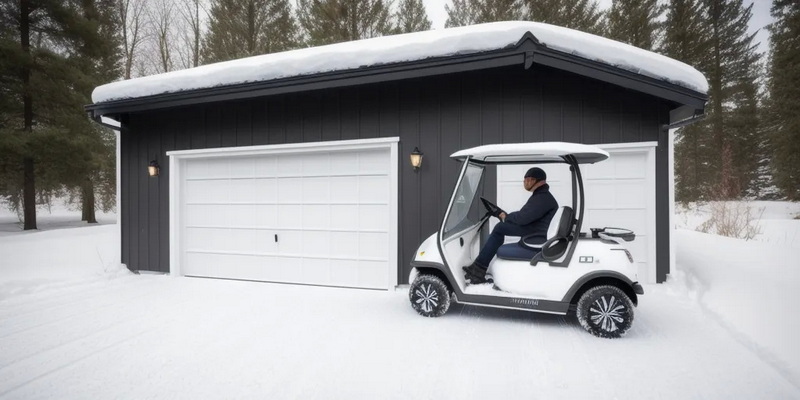Content Menu
● Preparing Your Golf Cart for Winter Storage
>> 1. Clean Your Golf Cart Thoroughly
>> 2. Battery Maintenance
>> 3. Tire Care
>> 4. Parking and Covering Your Golf Cart
>> 5. Inspect and Store Accessories
>> 6. Regular Check-Ins
● Best Practices for Winter Storage
>> Storage Location
>> Using a Golf Cart Cover
>> Battery Storage Tips
● Additional Tips for Specific Battery Types
>> Lithium-Ion Batteries
>> Lead-Acid Batteries
● Tips for Preparing Your Golf Cart for Spring
● Conclusion
● FAQs
>> 1. How Often Should I Check My Golf Cart Batteries During Winter Storage?
>> 2. Can I Leave My Golf Cart Outside During Winter?
>> 3. Do I Need to Disconnect the Battery During Winter Storage?
>> 4. How Do I Store Lithium-Ion Batteries in Extremely Cold Temperatures?
>> 5. What Happens If I Don't Charge My Golf Cart Batteries Before Winter Storage?
Storing an electric golf cart during the winter months is crucial to maintain its performance and longevity. Proper storage helps protect the cart from harsh weather conditions, corrosion, and battery damage. Here's a comprehensive guide on how to prepare and store your electric golf cart for the winter.

Preparing Your Golf Cart for Winter Storage
Before storing your electric golf cart, it's essential to follow a few key steps to ensure it remains in good condition until spring.
1. Clean Your Golf Cart Thoroughly
Cleaning your golf cart is the first step in preparing it for winter storage. Remove any dirt, debris, or grease from the body and components. This prevents moisture from accumulating and causing rust or corrosion. Use a mild detergent and water to clean the exterior, and dry it thoroughly afterward to prevent water spots.
2. Battery Maintenance
Proper battery care is vital for electric golf carts. Here are some tips:
- Fully Charge the Battery: Ensure the battery is fully charged before storage. For lithium-ion batteries, it's recommended to keep them between 60% and 80% charged, but for lead-acid batteries, they should be fully charged.
- Check and Add Distilled Water: If you have lead-acid batteries, check the water levels and add distilled water as needed.
- Clean Battery Terminals: Clean the terminals to prevent corrosion.
- Disconnect Battery Cables: Disconnect the battery cables to prevent self-discharge and corrosion.
3. Tire Care
Check the tire pressure and inflate them to the recommended level. Proper tire pressure helps maintain the cart's stability and prevents damage during storage. Consider raising the cart off the ground using blocks or jack stands to reduce pressure on the tires.
4. Parking and Covering Your Golf Cart
Store your golf cart in a dry, covered area such as a garage or shed. If indoor storage isn't possible, use a high-quality golf cart cover to protect it from the elements. Ensure the cover is waterproof and UV-resistant to prevent damage from sunlight.
5. Inspect and Store Accessories
Remove any accessories that could be damaged by cold weather or moisture. Store them in a dry place to ensure they remain functional when needed again. This includes items like golf bags, seats, and any electronic devices.
6. Regular Check-Ins
If possible, check on your golf cart periodically during the winter to ensure everything remains in good condition. This is especially important if you're storing it outdoors.
Best Practices for Winter Storage
Storage Location
Ideally, store your golf cart in a garage or shed. These locations provide protection from snow, ice, and freezing temperatures. If indoor storage isn't available, consider using a carport or a covered outdoor area. Ensure the storage area is well-ventilated to prevent moisture buildup.
Using a Golf Cart Cover
Invest in a high-quality, water-resistant golf cart cover if you can't store your cart indoors. This will protect it from moisture and UV damage. Look for covers with breathable materials to prevent condensation inside the cover.
Battery Storage Tips
- Lithium-Ion Batteries: These batteries drain slowly and can be stored with minimal maintenance. However, if temperatures will drop below -20°F (-29°C), remove the battery and store it in a warmer location.
- Lead-Acid Batteries: Regularly check water levels and charge them every 30 days to prevent deep discharge.

Additional Tips for Specific Battery Types
Lithium-Ion Batteries
Lithium-ion batteries are more resistant to cold temperatures but still require proper care:
- Charge Before Storage: Ensure the battery is fully charged before storage, but for long-term storage, keep it between 60% and 80% charged.
- Unplug the Charger: After charging, unplug the charger to prevent overcharging.
- Avoid Extreme Temperatures: While lithium-ion batteries are more durable, extreme cold can affect their performance. Keep them in a location with stable temperatures if possible.
Lead-Acid Batteries
Lead-acid batteries require more maintenance:
- Regular Water Checks: Check water levels monthly and top off with distilled water as needed.
- Trickle Charging: Consider using a trickle charger to maintain the battery charge during storage. This helps prevent deep discharge and prolongs battery life.
- Cleanliness: Ensure the battery terminals are clean and free of corrosion to maintain good electrical connections.
Tips for Preparing Your Golf Cart for Spring
When spring arrives, it's time to prepare your golf cart for use again. Here are some steps to follow:
- Inspect the Cart: Check for any damage or wear from storage. Look for signs of corrosion, rust, or water damage.
- Reconnect the Battery: Reconnect the battery cables and ensure they are secure.
- Charge the Battery: Charge the battery fully before use.
- Check Tire Pressure: Inflate the tires to the recommended pressure.
- Test the Cart: Take the cart for a test drive to ensure everything is functioning properly.
Conclusion
Properly storing your electric golf cart during the winter is essential to maintain its performance and extend its lifespan. By following these steps and tips, you can ensure your cart is ready to go when spring arrives.

FAQs
1. How Often Should I Check My Golf Cart Batteries During Winter Storage?
It's recommended to check the battery charge status every 30 days during winter storage. For lead-acid batteries, also check water levels monthly.
2. Can I Leave My Golf Cart Outside During Winter?
While it's possible to store your golf cart outside, it's best to use a high-quality cover to protect it from the elements. Ideally, store it in a covered area like a garage or shed.
3. Do I Need to Disconnect the Battery During Winter Storage?
Yes, disconnecting the battery cables can help prevent self-discharge and corrosion. This is especially important for long-term storage.
4. How Do I Store Lithium-Ion Batteries in Extremely Cold Temperatures?
If temperatures will drop below -20°F (-29°C), remove the lithium-ion battery from the cart and store it in a warmer location above -20°F (-29°C).
5. What Happens If I Don't Charge My Golf Cart Batteries Before Winter Storage?
Failing to charge your batteries before storage can lead to freezing of the cells and irreversible damage, especially for lead-acid batteries.










































